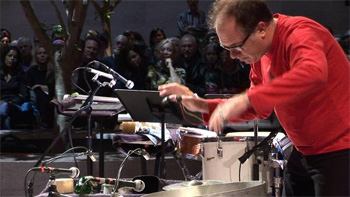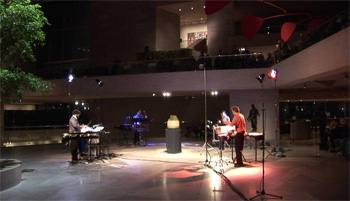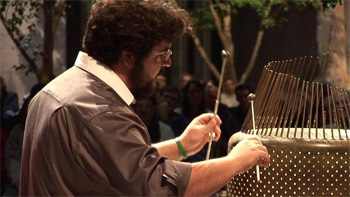Seeing "Sanctuary": One-Night-Only Screening at UC San Diego of World Premiere Concert Video
San Diego, CA, February 25, 2008 -- Pulitzer Prize-winning composer Roger Reynolds created his newest work, "Sanctuary", with the massive I.M. Pei-designed atrium of the East Wing of the National Gallery of Art in mind. The work had its world premiere there last November, but now, for one night only, San Diegans will get the chance to see that critically-acclaimed performance on the big screen - thanks to a concert film in high-definition video and 5.1 surround sound audio, to be shown at the California Institute for Telecommunications and Information Technology (Calit2) on the campus of the University of California, San Diego.
|
On Thursday, Feb. 28, the three-movement, 75-minute "Sanctuary" video will be displayed on the massive 4K Sony projector and beamed onto the 30-by-20-foot screen in the Calit2 Auditorium of Atkinson Hall. The projector is capable of displaying video at four times the resolution of high-definition TV. The video was produced by Calit2 with support from the UCSD Department of Music, the National Gallery of Art, and the Contemporary Music Forum.
The video will be introduced by "Sanctuary" composer Roger Reynolds, a professor of music at UCSD and Composer-in-Residence in the UCSD division of Calit2. Following the screening, Reynolds - the founding director of UCSD's Center for Research in Computing and the Arts (CRCA), and winner of the Pulitzer Prize for Music in 1989 - and fellow UCSD music professor Steven Schick will engage the audience in a Q&A session. Schick, a world-renowned percussionist, performed the solo first movement, "Chatter/Clatter", at the world premiere in Washington D.C. The subsequent movements - "Oracle" and "Song" - were performed by the UCSD graduate-student ensemble red fish blue fish (percussionists Justin DeHart, Ross Karre, Fabio Oliveira and Greg Stuart). Behind the scenes, computers programmed by Ian Saxton and Jacob Sudol (using the Max and PD software environments developed at UCSD by CRCA deputy director Miller Puckette) processed portions of the live performance electronically and fed the sounds back into the performance.
|
Also in the Washington Post , writer Andrew Lindemann Malone praised Reynolds' work, noting that the performance filled the atrium "with waves of gorgeous, purposeful, minutely detailed sound… Surrounded by speakers, the audience sat on the mezzanine and bridge of the atrium as well as its ground floor, for a once-in-a-lifetime aural experience." That experience arose from a variety of 'found objects' played by the performers, and the sound was manipulated electronically and fed to the speakers to take advantage of the atrium's unique acoustics. Pushing the technological envelope, Steven Schick's fingers were wired into a PC via tiny piezoelectric sensors attached to his fingertips; the technology allowed Schick to amplify the sound of even the tiniest of finger movements.
|
The performance in Washington, D.C. was captured in HD by Calit2 staffers Alexander Matthews and Hector Bracho, and edited by Matthews. The video was executive produced by Roger Reynolds and Doug Ramsey, in collaboration with Steve Antosca, Artistic Director of the Contemporary Music Forum, which co-commissioned "Sanctuary" with the red fish blue fish percussion ensemble, the National Endowment for the Arts, and the Randy Hostetler Living Room Fund.
|
[This Thursday, Feb. 28, "Sanctuary" will begin at 6PM, preceded at 5:30PM by a brief reception open to the public, on the first floor of Atkinson Hall. The screening will be followed by a Q&A session from 7:30-8PM. For information on parking and how to get there, go to http://atkinsonhall.calit2.net/directions.]
Related Links
National Gallery of Art Program
Media Contacts
Media Contact: Doug Ramsey, 858-822-5825, dramsey@ucsd.edu




